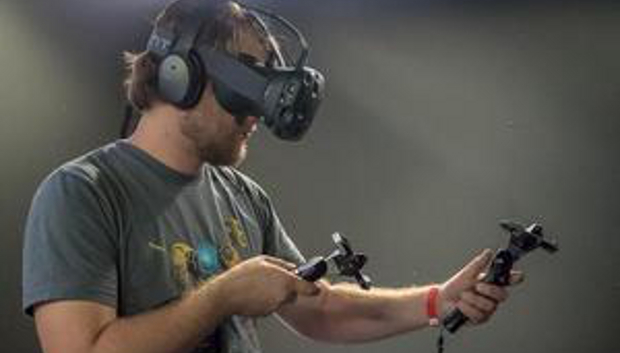 Last week I had an experience that has convinced me Virtual Reality is the future of human computer interaction. At a demonstration of the HTC Vive at a secret location in the city earlier this month I was treated four immersive experiences ranging from exploring a shipwreck on the sea bed to preparing a bowl of soup to taking apart a robot. Having already used an Oculus Rift and Google Cardboard I was used to full 360 degree, 3D navigation and had until then felt let down by blurry images. After this more refined demonstration I can say I’m just a few apps, a better PC and a proper release date away from making a significant purchase. Would I recommend it to a friend? I’d give it a guarded ‘yes’ so long as the mistakes of past failed home entertainment technologies are addressed.
Last week I had an experience that has convinced me Virtual Reality is the future of human computer interaction. At a demonstration of the HTC Vive at a secret location in the city earlier this month I was treated four immersive experiences ranging from exploring a shipwreck on the sea bed to preparing a bowl of soup to taking apart a robot. Having already used an Oculus Rift and Google Cardboard I was used to full 360 degree, 3D navigation and had until then felt let down by blurry images. After this more refined demonstration I can say I’m just a few apps, a better PC and a proper release date away from making a significant purchase. Would I recommend it to a friend? I’d give it a guarded ‘yes’ so long as the mistakes of past failed home entertainment technologies are addressed.
At the Visual Effects & Animation Summit I got to talk to some of the people getting to grips with Virtual Reality and its potential applications. What impressed me most was how the lessons from mobile were being absorbed into a technology that was getting reinvented not just as a device not just for gaming but more generalised ‘experiences’ like going to a concert and getting on-stage, base jumping off a cliff or fixing an engine. Are they convincing? My guide from HTC told me about the ‘VR grimace’ – the expression of awe each one of the demonstration’s participants had when the headset came off. It wasn’t just me who got the yips looking over the bow of a computer-generated shipwreck.
Back in 2013 I looked at the three factors that would define the success at another technology set to revolutionise home entertainment: 3D. At the time I argued that 3D would become the format of choice for consumers in their front rooms only if industry and content providers addressed the three Cs of content, convenience and cost.
The assumption that 3D would make the leap from the silver to the small screen if more films were made using it didn’t materialise for a number of reasons. 3D works in cinemas because chains have adopted it as a ‘premium’ first run format. That nine of the top 10 grossing films of all time were released in 3D after 2009 and the outlier, Titanic, got a 3D run in 2012, the technology has proved itself commercially and found a natural place in the multiplexes alongside IMAX and THX sound systems.
Getting 3D into the home required a killer app the cinemas couldn’t replicate and that meant a shift away from scripted content to sports, which had been instrumental in pushing high definition. Adding depth didn’t correspond to adding value, however, and without compelling broadcast support, streaming or rental options, your chance of watching anything in 3D at home now are limited to anyone with a compatible TV, Blu-ray player and whatever hard copies you own. Sky says it hasn’t given up on the format but replacing its broadcast channel with an on-demand service reeks of spin.
Pricing
On the issue of cost. A 3D TV is still a good TV, a virtual reality headset which has outlived its novelty value is a doorstop. Google’s Cardboard viewer costs less than €30 but the Oculus Rift is expected to cost €200 when it goes on sale next year. That’s a lot of money for a peripheral you won’t be using every day.
Another problem 3DTV struggled with was standardisation. Toshiba tried to bring a glasses-less 3D set to market but it had poor picture quality compared to sets using active shutter lenses and only delivered a depth effect when viewed in a specific position. VR faces a similar problem. What you get on the Rift should be the same quality as you get on Sony’s Morpheus, Samsung’s Gear VR, Razer’s OSVR or the Vive. Oculus is tackling this by opening up its APIs and partnering with competitors like Samsung – even at the expense of speed to market. This ‘get the platform right’ approach lifted from the mobile space that will see VR find a space somewhere between our tablets and our televisions.
I won’t be first in line when the Rift goes on the sale next year. I’m adopting the same strategy I have for Apple devices: take an interest in every second generation where the feature set catches up to the rest of the market. Then again I still use an iPhone 4s, so maybe I’m not the best role model when it comes to upgrades.
UPDATE: HTC has confirmed via Facebook that the Vive will go on sale in April 2016. No word on pricing just yet.







Subscribers 0
Fans 0
Followers 0
Followers